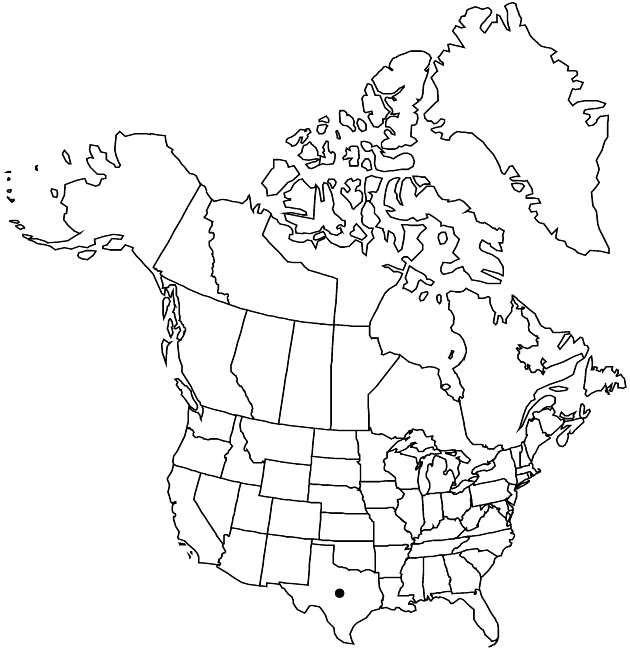Difference between revisions of "Perityle lindheimeri var. lindheimeri"
Endemic
Treatment appears in FNA Volume 21. Treatment on page 332.
FNA>Volume Importer |
imported>Volume Importer |
||
| (6 intermediate revisions by 2 users not shown) | |||
| Line 1: | Line 1: | ||
{{Treatment/ID | {{Treatment/ID | ||
|accepted_name=Perityle lindheimeri var. lindheimeri | |accepted_name=Perityle lindheimeri var. lindheimeri | ||
| − | |accepted_authority= | + | |accepted_authority= |
|publications= | |publications= | ||
| + | |special_status={{Treatment/ID/Special_status | ||
| + | |code=E | ||
| + | |label=Endemic | ||
| + | }} | ||
|basionyms= | |basionyms= | ||
|synonyms= | |synonyms= | ||
| Line 18: | Line 22: | ||
|habitat=Crevices of cretaceous limestone rock, often beside streams and springs | |habitat=Crevices of cretaceous limestone rock, often beside streams and springs | ||
|elevation=300–700 m | |elevation=300–700 m | ||
| − | |distribution=Tex | + | |distribution=Tex. |
| − | |discussion=<p>Variety lindheimeri is widely distributed on the Edwards Plateau. The more numerous, smaller, radiate heads and ovate leaves distinguish it from the related Perityle angustifolia, which has larger, discoid heads and linear to lanceolate leaves.</p> | + | |discussion=<p>Variety lindheimeri is widely distributed on the Edwards Plateau. The more numerous, smaller, radiate heads and ovate leaves distinguish it from the related <i>Perityle angustifolia</i>, which has larger, discoid heads and linear to lanceolate leaves.</p> |
|tables= | |tables= | ||
|references= | |references= | ||
| Line 28: | Line 32: | ||
-->{{#Taxon: | -->{{#Taxon: | ||
name=Perityle lindheimeri var. lindheimeri | name=Perityle lindheimeri var. lindheimeri | ||
| − | + | |authority= | |
| − | |authority= | ||
|rank=variety | |rank=variety | ||
|parent rank=species | |parent rank=species | ||
| Line 38: | Line 41: | ||
|habitat=Crevices of cretaceous limestone rock, often beside streams and springs | |habitat=Crevices of cretaceous limestone rock, often beside streams and springs | ||
|elevation=300–700 m | |elevation=300–700 m | ||
| − | |distribution=Tex | + | |distribution=Tex. |
|reference=None | |reference=None | ||
|publication title= | |publication title= | ||
|publication year= | |publication year= | ||
| − | |special status= | + | |special status=Endemic |
| − | |source xml=https:// | + | |source xml=https://bitbucket.org/aafc-mbb/fna-data-curation/src/2e0870ddd59836b60bcf96646a41e87ea5a5943a/coarse_grained_fna_xml/V19-20-21/V21_830.xml |
|tribe=Asteraceae tribe Heliantheae | |tribe=Asteraceae tribe Heliantheae | ||
|subtribe=Asteraceae (tribe Heliantheae) subtribe Peritylinae | |subtribe=Asteraceae (tribe Heliantheae) subtribe Peritylinae | ||
Latest revision as of 20:14, 5 November 2020
Pappi usually of 1(–2) bristles 0.5–1.8 mm plus vestigial, laciniate scales or obscure callous crowns, rarely 0. 2n = 34.
Phenology: Flowering spring–fall.
Habitat: Crevices of cretaceous limestone rock, often beside streams and springs
Elevation: 300–700 m
Discussion
Variety lindheimeri is widely distributed on the Edwards Plateau. The more numerous, smaller, radiate heads and ovate leaves distinguish it from the related Perityle angustifolia, which has larger, discoid heads and linear to lanceolate leaves.
Selected References
None.
Lower Taxa
None.
